Nobody could have predicted the chain of events put into motion on a Sunday in 2005 when Wallace Yay, an immigrant from war-torn Myanmar, walked through the doors of Gaston Oaks Baptist Church in Dallas.
“I traveled on this road often and at first I didn’t recognize that there was a church here,” Yay says of the unassuming office building on a busy corner in the northeast part of the city. He looked closer, and when he and his wife stopped in, they were pleased with what they found. “The pastor was very kind and treated us very well.”
Yay and his wife, members of the Karen people of Burma who came to the United States in 1997, began bringing more of their community who lived nearby. They sat in a group with Yay translating the scriptures, hymns and sermons until their numbers became too many, even with translation devices provided by the church.
“We started asking for permission if we could have a separate service because many of our people are not familiar with the English language and they couldn’t follow everything,” says Yay.
Gaston Oaks provided separate space, and while the sudden departure of the growing Karen group revealed more clearly that the Gaston congregation was dwindling, that act of generosity marked the birth of a bustling center for mission work both locally and around the globe.
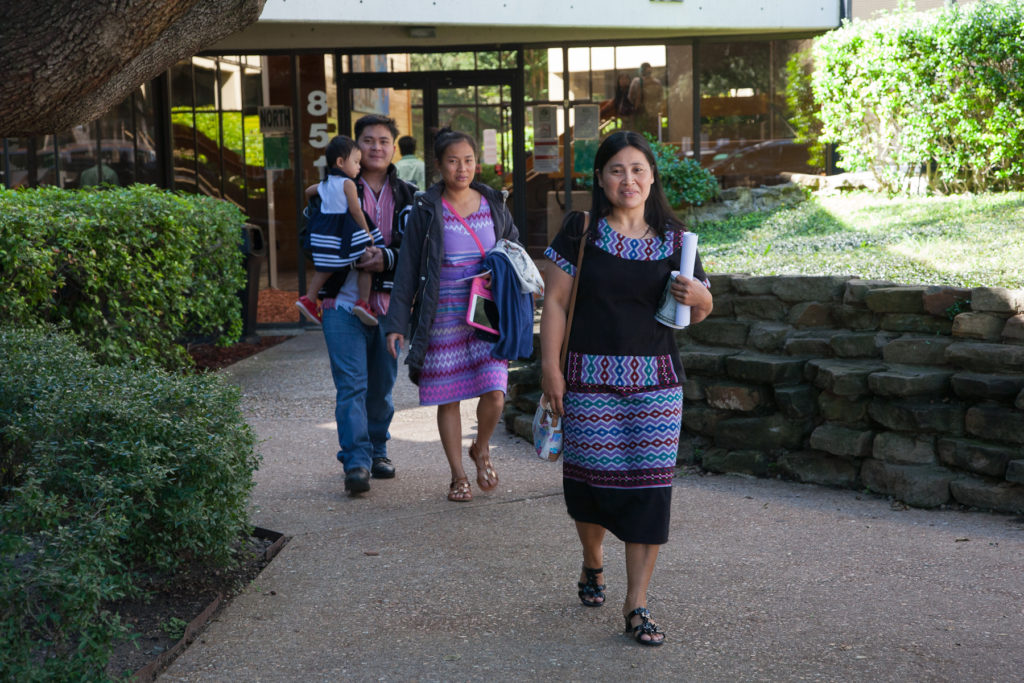
Members of Karen Baptist Church leaving Gaston Christian Center.
Gaston Christian Center is the surprising yet logical progression of Gaston Avenue Baptist Church, for decades a powerhouse in old East Dallas with a peak membership of 7,000 and a legacy of producing more foreign missionaries than any other church affiliated with the Southern Baptist Convention. Confronted with declining membership as the neighborhood around it changed, the church sold its property in 1990 and moved nine miles north to a 66,000-square-foot, two-story office building. Renamed Gaston Oaks, the church hoped to attract young families from the nearby North Dallas and Lake Highlands neighborhoods but new people didn’t come. The future looked bleak until Wallace Yay walked in.
Yay’s curiosity and Gaston’s hospitality led to the formation of the Karen Baptist Church, and other ethnic congregations followed. Gaston Christian Center was formalized in 2012 as a ministry of Gaston Oaks with leadership from other partner churches and nonprofit organizations.
Today, Gaston Christian Center hosts more than 2,000 people weekly for worship services, medical care, educational activities and community events. The Karen Baptist Church has been joined in recent years by La Promesa Iglesia Batista (Hispanic); Afrika Community Fellowship (East Africa); Chin Agape Baptist Church (Burmese); Zomi Baptist Church (Burmese); and Bhutanese Fellowship.
Also in the building is Healing Hands, a medical, dental and behavioral health clinic; Gateway of Grace, which provides support, classes and other services for refugees primarily from the Middle East; Kids University, offering after-school and summer tutoring to children in nearby apartment communities; the Korean-American Sharing Movement that distributes tons of food and relief supplies to orphans in Korea; Bakke Graduate University, an on-line missions-oriented school with students from around the world; an office for a Dallas-based administrator of the World Evangelical Alliance; and a tax and financial services firm that works with immigrants.
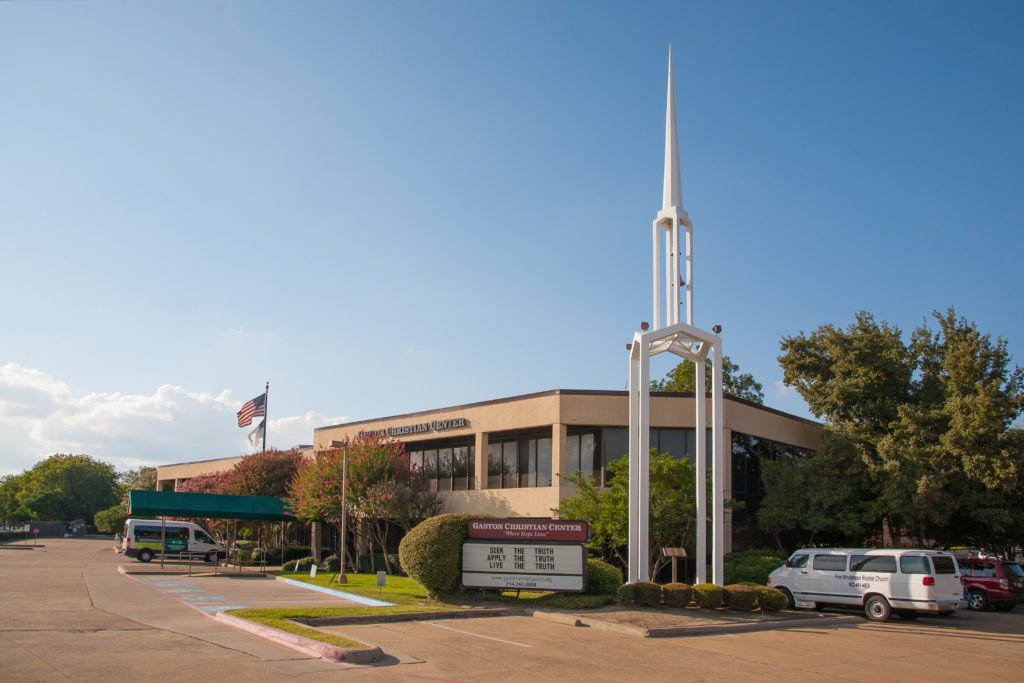
This church began as Gaston Avenue Baptist Church and is the founding congregation of Gaston Christian Center. They are the oldest church at GCC but now the smallest.
Colors of the world
On any given Sunday, Gaston Christian Center teems with the colors and languages of Africa, the Far East, Central America and the Middle East. While some dress in the latest fashions of their adopted country, some still don the traditional clothing of their homelands. And some wear a mixture; a young girl pairs a traditional red dress with a red Adidas jacket.
Hsa Twel, pastor of the Karen Baptist Church, wears a sports coat in the blue and white stripes of his native culture as he speaks to his flock. Twel’s journey mirrors that of many of his congregants who are refugees from the decades-long civil war in Burma, now called Myanmar. Twel was born in Burma and grew up in refugee camps on the Burma-Thailand border.
“My life in Burma was very difficult when I was a child,” he says. “I had no chance to go to school because normally we had to prepare to run away because of the fighting between the Burmese and Karen people.” His father was arrested by the Burmese authorities and killed.
“Even though I wanted to go to further study, after you pass the 10th grade you were finished,” he adds. “In the refugee camp a lot of my friends decided to go to Bible school, so I followed my friends. I studied there, and that’s when I, by the grace of God, served the Lord quite early.”
Twel served on the border for three years before traveling to New York City in November 2008. Two months later he came to Dallas to lead the Karen Baptist Church. In that same year, Gaston Oaks called Gary Cook out of retirement from a long career in Baptist pastoral and denominational work to be its interim pastor. He was instrumental in helping the church find its legacy with Gaston Christian Center, and he found a new calling of his own.
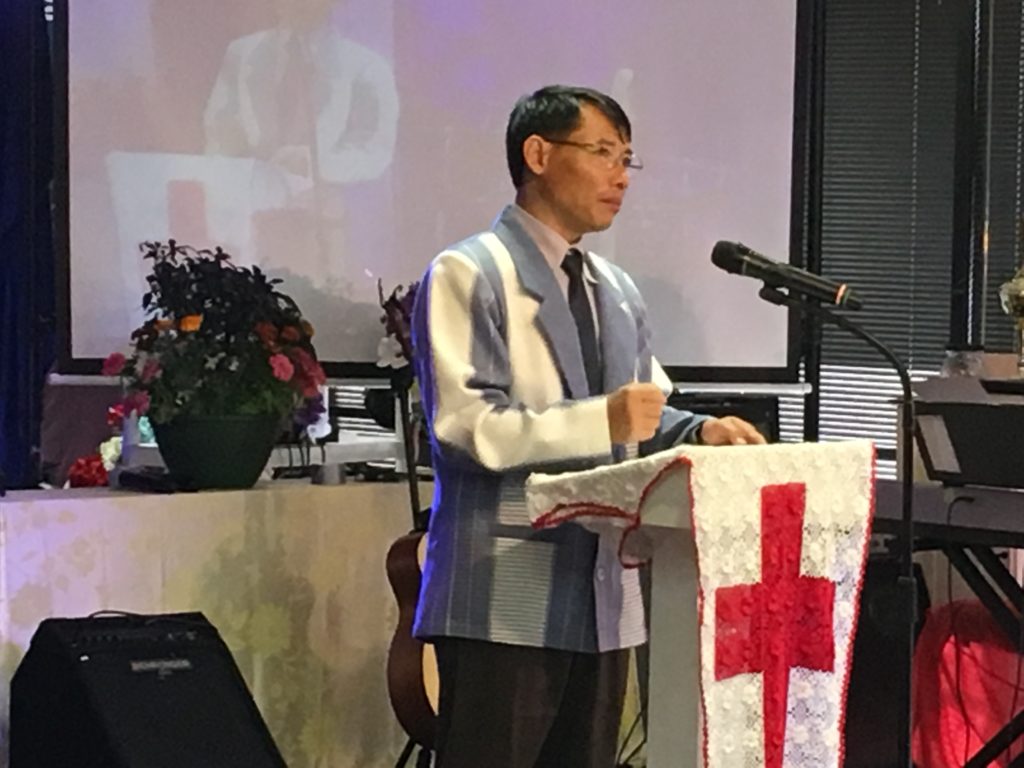
Pastor Hsa Twel of Karen Baptist Church held at Gaston Christian Center.
“This has been a learning experience for me. I had never done anything comparable to this in all of my years of ministry,” he explains. “It was very appealing to me to do hands-on missions work, but I have had to learn how to do it and how to work with these ethnic pastors.”
While Cook’s primary ministry is to his own congregation – and he has committed to staying with them until there are no more living members – he has welcomed the opportunity to mentor the other pastors whose congregations share the building. Vision and reality don’t always match up, however.
“Pastor Gary sets up a pastors’ meeting once a month but we all can’t meet at the same time,” says Twel. “He still plans it, but we have difficulty understanding each other. Last year every three months we had a combined service and especially at Easter and Christmas Sunday.”
An overarching challenge has been getting all the congregations and missions organizations settled into the building together. The center’s daily operations are directed by Bill O’Brien, well-known internationally for his work in Baptist global missions, especially in Indonesia. He regards the brick-and-mortar structure around him as a “servant building” that provides the space and resources for ministries and services that are deliberately Christian and that have both a local and global reach.
“If two of our greatest challenges in this country are immigration and health care, then we’re a microcosm of that in this building,” he says.
Sharing Resources
Sundays at Gaston Christian Center are a carefully orchestrated coming and going of people. The main worship center is shared by three congregations through the day, while another large space – the activity center – is shared by two more. The Karen and the Bhutanese each have their own dedicated spaces, but worship times are still spread out to make best use of the parking lot.
“We are very thankful to Gaston Christian Center. Even though we were the first congregation that assembled, they gave us space that we don’t need to share,” says Twel, explaining it can be “complicated” to share space when worship services have different needs and widely varied ending times. As such, the Karen’s large space upstairs is well-outfitted with sound and video equipment and pews donated by a church in Oklahoma for the 200-plus congregants.
Worship with the Karen is a mixture of old and new, Karen and American. On a recent Sunday, a children’s choir sings a song in their own language, but later a volunteer choir goes English with the 1920s gospel song “Yes, I Know.” Kuhn Taw, a church “chairman,” gives a sermon in his native tongue until he holds up a smartphone and says, “This is a phone, not a Bible.” He returns to his native language for a while and then says, “What we need and what we want – we cannot separate it.”
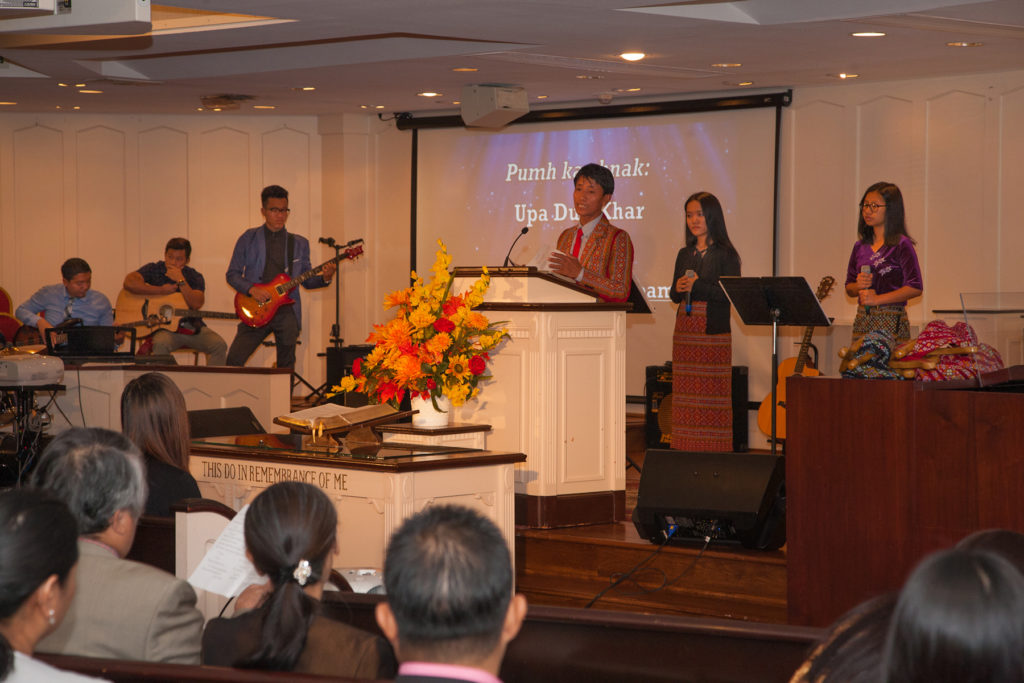
Worship at Chin Agape Baptist Church held at Gaston Christian Center.
While Twel is leading the Karen worship upstairs, Chan Thui is doing the same on the first floor with the Chin Agape Baptist Church – the largest congregation in the building and one that shares the Worship Center with Gaston Oaks. When the Chins asked if they could worship later in the morning so they could stay for afternoon activities, their hosts responded with signature hospitality.
“Our people at Gaston Oaks made the decision to move our worship from 11 a.m. to 9 a.m.,” says Cook. “For some churches, moving the worship time would have been the last straw. But it’s in their DNA to make accommodations for other communities.”
Sharing is at the heart of what makes Gaston Christian Center work, adds O’Brien. All the congregations have access to a preschool area, a prayer room, the fellowship hall and a media library built on the collection from Gaston Avenue Baptist Church. To keep things orderly, an administrative assistant at Gaston Oaks fills the calendar on a first-come, first served basis.
Perhaps the most remarkable example of sharing is that while it has no youth of its own, Gaston Oaks has a young associate minister who serves the youth of the ethnic congregations at their request. Like many Anglo churches, the ethnic congregations are feeling the pull on their youth from other activities and influences.
The ethnic churches help each other, too. One year the Chins bought 125 Spanish language Bibles for an outreach project of the Hispanic church. The Karen did the same thing the next year.
While Gaston Christian Center continues to grow in activity, Cook acknowledges that Gaston Oaks’ days are numbered. With membership of about 100, less than 50 attending and an average age of 83, the church prepared for the inevitable in 2015 by signing over the deed for its property to the board of Gaston Christian Center. Gaston Oaks is now a rent-paying tenant with all the other churches and organizations sharing the building. This could be a time of sadness, Cook says, but there is joy in the original church for what has happened.
“Gaston Oaks needed young families and babies,” he says. “Well, now they have that. It just looks different” than what church members may have envisioned.
Wallace Yay, the first of the immigrants to be welcomed by Gaston Oaks, believes God is in the details.
“I believe that God helped us to have a place here in the church, and all the leaders and the congregants are very aware that God helps us in everything.”
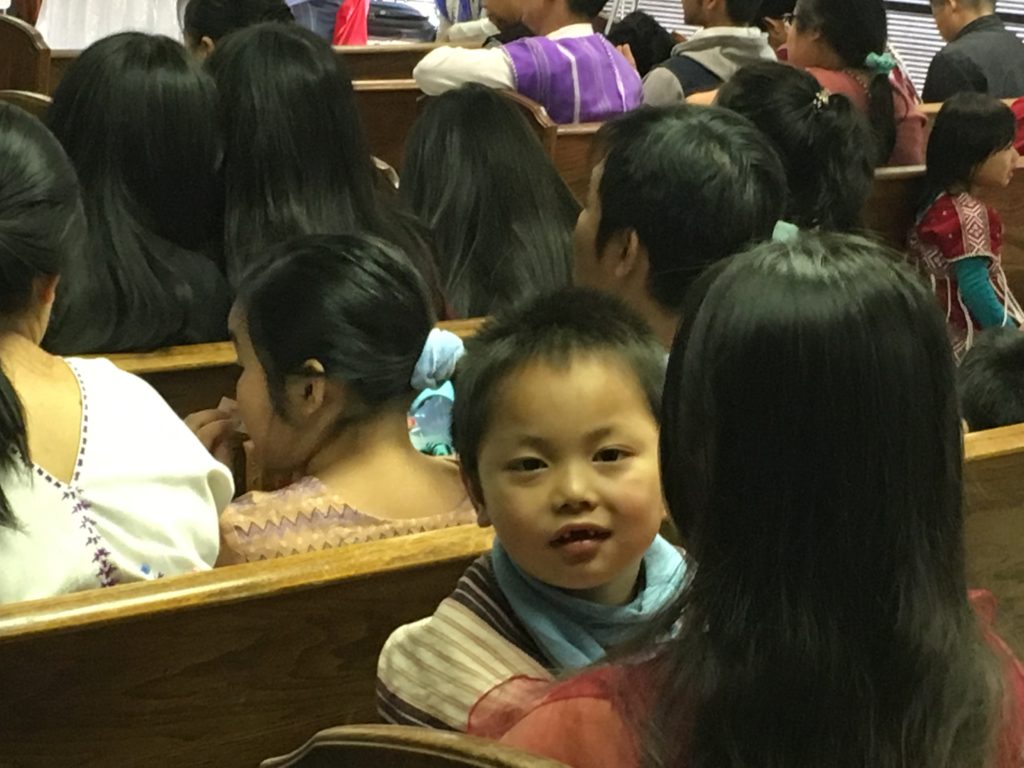
A child waits before worship at Karen Baptist Church held at Gaston Christian Center.
Read more in the Hospitality on the corner: Gaston Christian Center series:
Where the colors of the world worship together
Photo Gallery: Gaston Christian Center
Video: Chin Agape Baptist Church congregational singing
Video: Pastor Hsa Twel and Wallace Yay interview
Video: Karen Baptist Church children’s choir singing in their native language
Related commentary at baptistnews.com:
Humility, kindness and welcome: Hard but biblical callings | David Jordan
Is Jesus irrelevant to the immigration debate? | Alan Bean
Related news at baptistnews.com:
Volunteers in refugee programs fulfilling biblical mandate to care for strangers
This series in the “Welcoming the Stranger” project is part of the BNG Storytelling Projects Initiative. In “Welcoming the Stranger,” we share the inspiring stories of the people and faith communities that are teaching us all to love our neighbor as ourselves.
_____________
Seed money to launch our Storytelling Projects initiative and our initial series of projects has been provided through generous grants from the Christ Is Our Salvation Foundation and the Eula Mae and John Baugh Foundation. For information about underwriting opportunities for Storytelling Projects, contact David Wilkinson, BNG’s executive director and publisher, at [email protected] or 336.865.2688.


